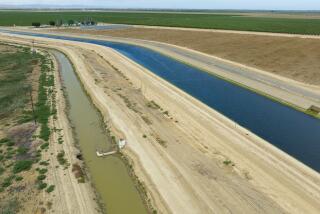Lungren, Feinstein spar over Hetch Hetchy Valley restoration
A call for an investigation into how San Francisco gets and consumes its water has sparked a feud between two congressional leaders on opposite sides of the aisle over a proposal to restore Hetch Hetchy Valley in Yosemite National Park, dammed 85 years ago to supply the city with clean water.
Rep. Dan Lungren (R-Gold River), has asked the Interior Department to determine whether the city’s use of 190 million gallons of Tuolumne River water per day, without first exhausting local resources, violates a law requiring that it import no more water than is necessary to meet its municipal purposes.
In an interview, the former California attorney general said an investigation would be a step toward his goal of taking out the Hetch Hetchy reservoir and restoring the scenic seven-mile valley that legendary naturalist John Muir described as a “mountain temple.”
“All I’m trying to do is crack open the door so that we can at least study the possibility of returning the valley to its natural state,” Lungren said. “Having another Yosemite Valley in California would be a tremendous thing.”
But Democrat Dianne Feinstein, California’s senior senator and a former mayor of San Francisco, said restoring Hetch Hetchy to its original splendor is out of the question.
“The suggestion that San Francisco is not using its water supply efficiently is simply not true,” Feinstein said in a statement. “Per person, Bay Area residents use less than half … the state’s per-capita average.”
Feinstein added, “Hetch Hetchy provides critical water supplies to 2.5 million people and thousands of businesses, and any effort to jeopardize that water supply is simply unacceptable.”
It is not the first time Lungren has locked horns with Feinstein and other leading Democrats, including Rep. Nancy Pelosi (D-San Francisco), over Hetch Hetchy.
In 2006, a survey by the state Department of Water Resources determined that restoring the valley would cost up to $10 billion, including compensation for lost power generation along the system of dams and reservoirs between the valley and San Francisco.
The survey drew a sharp response at the time from Feinstein, then chairwoman of a subcommittee that funded the Interior Department: “Draining the reservoir would be far too expensive and leave the state vulnerable to both drought and blackouts,” she said.
In 2007, Lungren endorsed a proposal in President Bush’s 2008 budget to allocate $7 million for an Interior Department study of the feasibility of restoring the valley. “The idea didn’t get anywhere,” Lungren recalled. “I got the strongest impression it was stonewalled by the strongest powers in the House.”
Lungren’s latest assault on the reservoir was welcomed by Mike Marshall, executive director of Restore Hetch Hetchy, a nonprofit advocacy group based in San Francisco.
“No one has ever taken this approach to the problem before; it’s brand new legal territory,” Marshall said. “If an investigation finds the city violated federal law and must reform its water system, there would be no need for the reservoir.”
In the meantime, he added, “the Tuolumne River remains San Francisco’s primary source of pristine Sierra Nevada water for hosing down sidewalks, tap water and flushing toilets.”
Lungren’s request for an investigation hinges on a provision buried within the Raker Act of 1913, which allowed San Francisco to dam the river and flood Hetch Hetchy Valley, provided the water was not unnecessarily exploited.
Since the 1920s, the valley has been covered by more than 300 feet of water behind O’Shaughnessy Dam. The water travels 160 miles by tunnel and pipeline, crossing the Central Valley and Coast Ranges to the Bay Area.
In a letter sent last week to Interior Department Secretary Ken Salazar, Lungren alleged that San Francisco failed to adequately invest in systems to recycle water, develop ground water supplies and harvest the 20 inches of rain it receives each year.
San Francisco does not use recycled water but plans to use up to 4 million gallons of it per day by 2035, he said. By way of comparison, Los Angeles uses 28 million gallons per day of recycled water and hopes to triple that amount by 2035.
In an interview, Michael Carlin, deputy general manager of the San Francisco Public Utilities Commission, denied Lungren’s allegations.
“We believe we are in full compliance with the Raker Act,” Carlin said. “One big problem with Congressman Lungren’s assessment is that he focuses on the city of San Francisco’s usage, and not our entire service area. Right now, we are recycling about 6 million gallons of water a day in the area, which includes 26 partner communities.”
“We are reviewing the accuracy of his letter to the Department of Interior and plan to file a response soon,” Carlin said.
More to Read
Sign up for Essential California
The most important California stories and recommendations in your inbox every morning.
You may occasionally receive promotional content from the Los Angeles Times.











